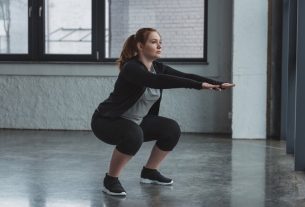Shoulder training at home is simple, easy and helps you achieve different goals, from toning, improving the stability and strength of the deltoid, trapezius and arm muscles, increasing muscle volume to shoulder hypertrophy and should be added to your exercise routine weekly.
For best results, these shoulder exercises should be done using weights such as a plastic bottle with sand or backpacks with a bag of rice or beans, or dumbbells, barbells or kettlebells, for example. However, it is important to take into account the physical conditions and limitations of the body to avoid any type of injury such as deltoid rupture or tendonitis, for example.
Therefore, the ideal is to have a medical evaluation before starting any physical activity and have guidance from a physical educator who must indicate the weight for each exercise individually.
How to do shoulder training
Shoulder training at home can be done 2 to 3 times a week, in 2 to 3 sets of 10 to 12 repetitions, depending on the exercise. The ideal is to choose 3 to 4 exercises per workout.
It is important to warm up before exercising, and it is a good option to move your arms up and down alternately, several times at a fast pace or do jumping jacks, for example.
Some exercise options to do a complete shoulder workout at home are:
1. Push-up with feet elevated
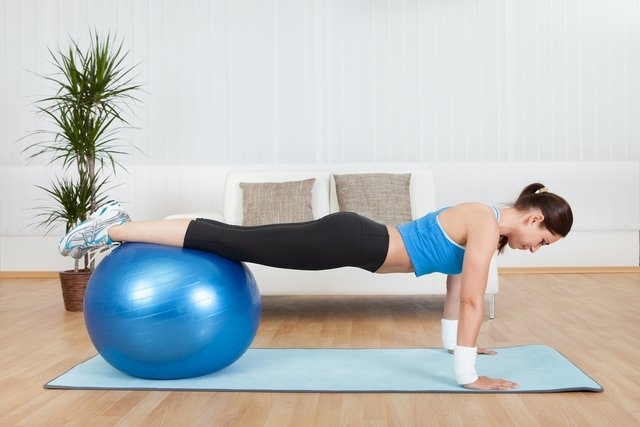
The push-up with feet elevated is an exercise that helps work on the strength and endurance of the deltoids, triceps and biceps. To perform this exercise, you must use a surface to create an inclination of the body, such as a stool, chair, puff, gym ball or a step exercise platform.
How to make: place your feet on the inclined surface, and raise your body by stretching your arms, with your hands a little more than shoulder-width apart. The body must be straight and with the back aligned with the torso. Contract your abdomen, flex your elbows until your chest is close to the floor and return to the starting position.
2. Side raise

The lateral raise works on the strength and endurance of the deltoid, trapezius and infraspinatus muscles. This exercise must be done using weights such as a plastic bottle with water or sand or backpacks with 1 or 2 kg of rice or beans in each one, or using dumbbells.
How to make: Standing with your feet hip-width apart and your arms at your sides, hold a weight in each hand. With your abdomen contracted, raise your arms to the sides, without bending your elbows and with your palms facing down, until they are at shoulder level. Lower your arms slowly.
3. Front raise

The front raise is another good exercise option to work on the strength and endurance of the deltoid and trapezius muscles, as well as stimulating an increase in muscle mass and volume. To achieve these goals, you should use weights such as a plastic bottle with sand inside or two backpacks with 1kg packages of rice or beans, for example, or dumbbells if you have them.
How to make: With your arms aligned in front of your body, hold the weight with your palms facing inward and shoulder-width apart. It is important that your arms are completely stretched and your abdomen is contracted. Lift the weight forward and upward to shoulder level, exhaling as your arms go up and inhaling as you come down. Return to starting position. See other ways to do the front raise.
4. Plank with arm raises
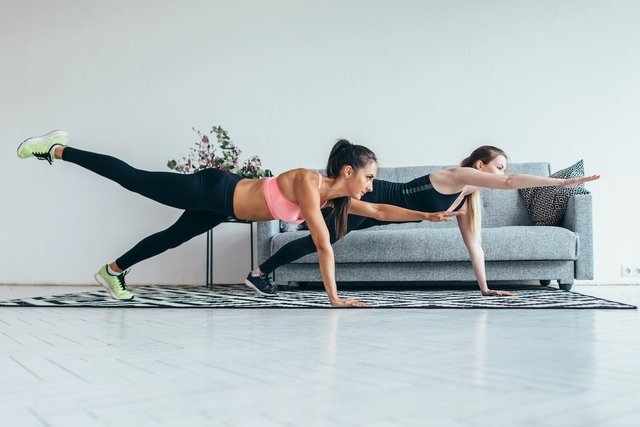
The plank with arm raises is considered a complete exercise, as it works the strength and stability of the deltoids, abdomen, core and other muscles of the body such as the biceps and triceps. There is no need to use weights or dumbbells for this exercise.
How to make: lie on your stomach and then raise your body, resting your hands and toes on the floor, always with your abdomen and glutes contracted and your head and body straight, aligned with your spine. Raise one leg, aligned with the body and extend the arm opposite the leg, for example, if you lift your left leg, extend your right arm in front. Return your arm to the starting position and then extend your arm to the side, keeping your leg elevated. Do 10 to 15 repetitions with your right arm and then your left arm. This exercise is not done in sets, however if the objective is to increase muscle strength, you can do 2 to 3 sets. If the exercise is very difficult, you can perform it without elevating your leg.
5. Development
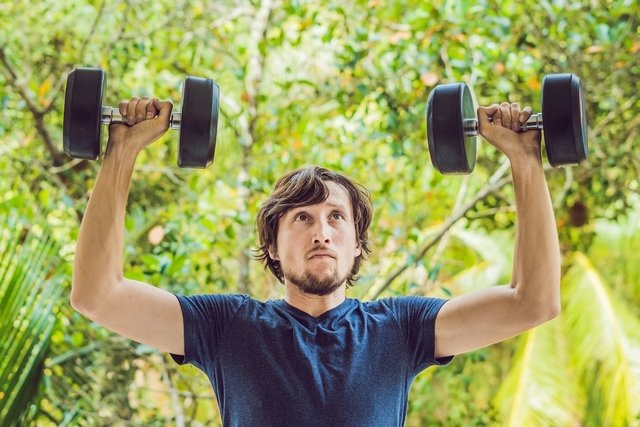
The shoulder development exercise allows you to strengthen and develop the anterior and lateral deltoid muscles, in addition to working the triceps, trapezius and upper pectoral muscles, making it a good option for people who want shoulder hypertrophy. This exercise must be done using weight such as one or more 1kg packages of rice or beans inside a backpack, using a plastic bottle with sand inside, for example, or using dumbbells, if you have them.
How to make: Sit on a bench or chair and place the weights so that your upper arm and forearm form a 90-degree angle. It is important that your palms face forward, your back is always straight and your abdomen is contracted. Lift the weights until your arms are straight and return to the starting position.
6. High row
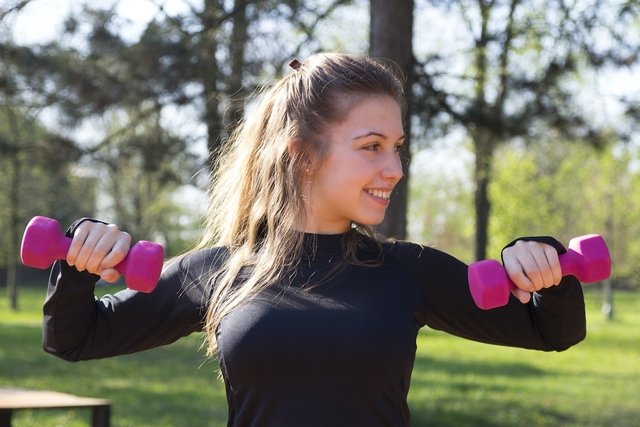
The upright row is an exercise that works on the strength, support and balance of the deltoid and trapezius muscles, in addition to the upper pectoral muscles, and must be done using weights such as a pet bottle with water or sand inside or using a bar or dumbbells, if you have one. these materials.
How to make: Standing, with your legs shoulder-width apart, hold the bar in front of your body with your arms extended, palms facing inwards, abdomen contracted and back straight. Pull the weight up, raising your elbow to shoulder height. Return to starting position.
What to do after training
After shoulder training, you should do stretches to help relax your muscles, tone your muscles, improve flexibility, increase circulation and prevent injuries.
1. Overhead stretch

This stretch allows you to stretch the deltoids, trapezius, chest and spine, and must be done standing or sitting.
How to make: Raise one arm and bend the elbow, placing the hand toward the back or back of the neck. With your other arm, pull your elbow toward your head to stretch your triceps. Do this movement for 20 to 30 seconds. Repeat with the other arm. This exercise is not done in sets.
2. Crossed Arms Stretch
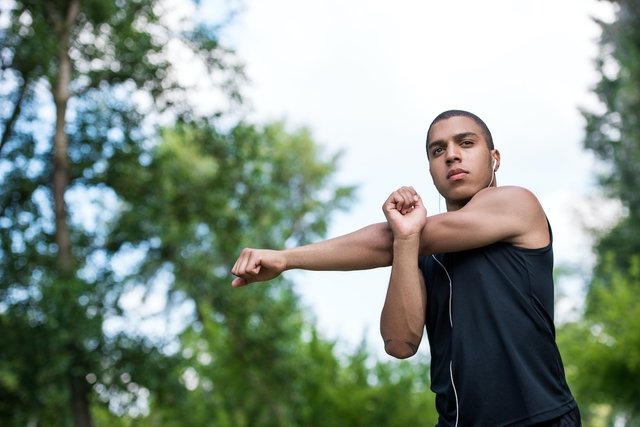
The crossed arms stretch allows you to stretch your shoulder and biceps muscles.
How to make: Standing, with your legs shoulder-width apart and your knees slightly bent, place your right arm across the front of your body, at shoulder height. With your left arm, hold your right arm in this position, pressing your right arm into your chest. Hold this position for 20 to 30 seconds and repeat with the left arm. You can do 3 to 4 repetitions for each arm.

Sign up for our newsletter and stay up to date with exclusive news
that can transform your routine!
Warning: Undefined array key "title" in /home/storelat/public_html/wp-content/plugins/link-whisper-premium/templates/frontend/related-posts.php on line 12
Warning: Undefined array key "title_tag" in /home/storelat/public_html/wp-content/plugins/link-whisper-premium/templates/frontend/related-posts.php on line 13

